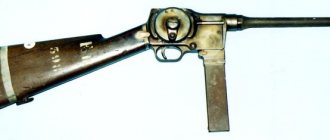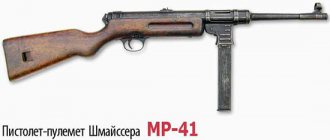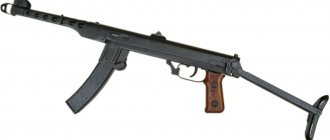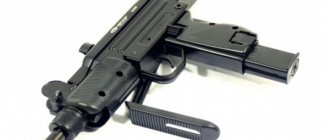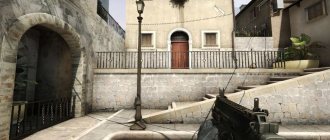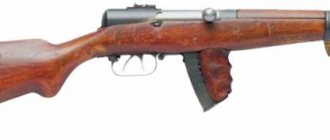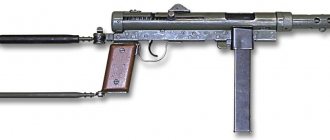The collapse of the Soviet Union, on the one hand, caused a revival of serious interest among security forces in compact and high-speed automatic weapons. On the other hand, he limited funding for its development and implementation into production to a minimum.
As a result, many promising samples turned out to be unclaimed. One of them was the compact 9mm Cheetah submachine gun, about which not much is known today.
The appearance of the “Cheetah” bears a resemblance to both a Kalashnikov assault rifle and a running cheetah
Having adopted the 1943 model intermediate cartridge and weapons for it, the Soviet military lost interest in the class of submachine guns for a long time.
The insignificant, as it seemed then, niche of a “free-hand weapon” for those military personnel for whom a full-size Kalashnikov was only a hindrance due to their occupation, was supposed to be closed with a Stechkin automatic pistol with a magazine for 20 rounds and the ability to fire in bursts.
Later, the so-called “shortcuts” appeared: AKMSU developed in 1959 and created 20 years later as part of the Modern competition AKS74U.
However, even in its shortened form, the Kalashnikov remained a fairly heavy and bulky weapon, while the cartridge used was clearly redundant for close combat tasks.
According to some reports, the USSR was still interested in submachine guns: both the Czech Scorpion and foreign models, but its own developments in this direction did not advance beyond experimental designs until the end of the 80s.
It is characteristic that at the same time in the West, although many models of assault rifles had shortened versions, submachine guns, such as the Heckler and Koch MP5, were widely used.
Experienced submachine gun Gepard (Russia)
In December 2001, newspapers reported that the construction of a new nuclear submarine Gepard had been completed at the Northern Machine-Building Enterprise (Sevmash).
Previously, such information was kept in the strictest confidence. Its disclosure now was obviously caused by the death of the submarine cruiser Kursk. Russia is losing submarines! In order to somehow optimize the situation that arose, we decided to lift the veil of secrecy: they say, we are not only losing. Izvestia quoted the words of the head of the military representative office of the Ministry of Defense at Sevmash, Pavel Nychko. When asked about comparing the relative characteristics of this boat and American submarines of a similar class, he said: “The Cheetah compared to NATO submarines is like a Mercedes compared to the Volga.”
Today we all have a good idea of what a Mercedes is and what advantages it has over the Volga, so it will be easy for us to imagine what kind of new Gepard boat this is.
Newspapers did not ignore the new Atomine this year either. It was reported that the boat had left for sea trials. They ended successfully. And here's some completely new news. At the end of November, factory workers are preparing to say goodbye to Gepard. There will be celebrations. Let's hope that they will show us the delivery of the boat to military sailors.
If you know the history of the construction of the boat, then this event will also be symbolic. The boat was laid down in the Sevmash workshops on September 23, 1991, when the Soviet Union still existed. Now this nuclear submarine has automatically become the first Russian submarine built, and even of the new millennium. So there are ten years of our unsettledness in the boat.
Gepard's predecessors left the plant two years after its foundation. Before the “Cheetah” there were “Leopard”, “Panther”, “Wolf”, “Leopard”, “Tiger”, “Vepr”. Sailors call this series of boats cat, although officially Project 971, to which the Gepard belongs, has the code “Pike-B”, and according to the NATO classification - “Shark-2”. Despite the difference in names, they are all close to the new boat. They note one main feature of the “cat” series - silent running. These are third generation boats.
Even under the most favorable conditions, the American Los Angeles-class submarine, which has the most advanced hydroacoustics, will be able to detect a “cat” boat no further than 10 kilometers away. This distance is critical. A nuclear submarine that has crept up unnoticed can already carry out its combat mission without hindrance.
American naval analyst N. Polmer, at a hearing in the National Security Committee of the US House of Representatives about Akula, as well as other third-generation Russian nuclear submarines, demonstrated that Soviet shipbuilders were closing the gap in noise levels faster than expected. In 1994 it became known that the gap no longer existed.”
Shock is our way
What will the new Cheetah boat be like? This is a double-hulled submarine with a high stern fin on which a towed antenna fairing is installed. The crew can conduct conversations with the ground even from under water. The boat's hull has a hydroacoustic coating and is divided into seven main compartments. Comfortable conditions have been created for the crew: a relaxation room, a gym and even a small sauna with a swimming pool. The living quarters for four people are very similar to the compartments of a passenger train.
Sailors who come to serve on the Cheetah will learn a lot of interesting things from the history of boats of this class. They will certainly be told about the incident that occurred on February 29, 1996, in the midst of NATO exercises. The warships were searching for a mock underwater enemy. The training task was completed, when suddenly... a Russian submarine made contact. Her commander asked for help. It was necessary to urgently evacuate a sailor with an acute attack of appendicitis.
Submachine gun SR-2 "Veresk"
It is quite natural that its own version of the SR-2 “Veresk” submachine gun was created for it. This design is based on a special VAL machine gun. Therefore, the submachine gun uses a gas-operated operating principle that is unusual for such a weapon. However, given the power of the SP-10 (9×21) cartridge, this approach is quite justified.
The layout of the weapon has been significantly changed compared to the base model. Thus, the magazine is located in the control handle, which improves the overall balance and makes the design more convenient for concealed carry. The stock folds onto the top of the receiver and does not increase the size of the weapon in the stowed position. The design of the cocking handle has also been changed.
Submachine gun "Veresk".
The target firing range is up to 200 m; confident destruction of targets protected by body armor is possible at a distance of 100 meters. The length of the weapon is 367 mm with the butt folded or 603 mm with the stock folded down. Weapon weight 1.65 kg. Magazine capacity is 20-30 rounds. Plastics are widely used in construction. In general, in terms of design and ammunition power, this weapon occupies an intermediate position between a submachine gun and an assault rifle and will most likely have good prospects as a special forces weapon.
Independent Military Review
5:02 / 06.06.17 Experienced Tokarev submachine gun PPT (USSR. 1927)
Even by modern standards, a submachine gun is a rather specific weapon and far from being suitable for widespread use. The small effective range of a pistol or, less commonly, revolver bullet makes it virtually useless even at medium distances. But at short range, such weapons show excellent results, mainly, of course, thanks to the ammunition used in them, which have a significantly greater stopping effect in comparison with common intermediate cartridges.
For some reason, many people believe that the submachine gun is a relatively young weapon and it appeared after automatic carbines and automatic rifles became widespread, but this is not entirely true. In fact, the first submachine gun appeared before the machine gun in the modern sense of the word, because at that time such a term did not even exist, but there were machine guns. The most interesting point is that initially it was submachine guns that were supposed to take the place of modern machine guns, and in some cases this was the case, but due to the small effective distance this did not happen. However, this weapon did not disappear, but found its niche, becoming an ideal option for firing in urban areas and inside buildings, where the range of use very rarely exceeds 150 meters.
One of the little-known domestic models of submachine guns is the PPT. This weapon changed its appearance several times, changed its cartridge, and even took part in World War II, but the Tokarev submachine gun never went into mass production. Let's try to figure out what kind of weapon it was, how different it is from modern models, and why it never managed to become widespread.
The PPT submachine gun is the brainchild of Fyodor Vasilyevich Tokarev, he worked on it in parallel with the development of the well-known SVT-40 rifle. The gunsmith himself called the sample a light carbine, since the term submachine gun simply did not exist at that time. It is noteworthy that even now, when discussing this sample, many insist that this model of weapon cannot be called a submachine gun due to the fact that it uses 7.62 cartridges almost exactly the same as in Nagan revolvers. The only difference between the cartridges was that the neck of the cartridge case was additionally crimped for a more reliable supply of cartridges. Of course, you can argue on this issue until you’re blue in the face, but you can’t call a revolver-machine gun a weapon just because it uses non-pistol cartridges. In general, the appearance of the PPT really looks more like a carbine than a submachine gun in the modern sense, but here the reason lies primarily in the age of the weapon, and less labor intensity in production also plays a significant role.
A rather unusual appearance for a PP was provided by a wooden stock and an upper pad, which was held in place by a stock ring. An interesting feature was that the weapon magazine was located in a wooden plate, in which depressions were sawn to make it more convenient to hold the weapon. The submachine gun was fed from a detachable magazine with a capacity of 21 rounds. The sights were also not quite ordinary. So, for shooting up to 100 meters, non-adjustable front and rear sights were used; in addition, for shooting at distances of 100 and 150 meters, there were folding diopter rear sights. The submachine gun did not have an automatic bolt stop; instead, a manual bolt stop was used, with which the shooter manually fixed the bolt in the rearmost position when reloading was necessary; subsequently, the weapon also received an automatic bolt stop when all the cartridges from the magazine were used up.
Another feature of the PPT submachine gun was a fairly high rate of fire, equal to 1000 rounds per minute, and it should be noted that at a distance of 200 meters, a revolver bullet pierced 3 pine boards an inch thick and installed at a distance of an inch from each other. Based on this, we can say that, despite the not the highest stopping effect of a revolver bullet, due to the high rate of fire, the Tokarev submachine gun had quite good efficiency, even when shooting at protected targets, which, in principle, was not the case at that time relevant.
The design features a slide stop when the magazine is empty / Photo: huntsmanblog.ru
A spare magazine of the Tokarev submachine gun is hidden in the plane of the butt / Photo: huntsmanblog.ru
In 1927, during field tests of this type of weapon, a competitor to the submachine gun was presented. It was the German PP MP-18, chambered for 9x19. When comparing both weapon models, for some reason completely incorrect conclusions about effectiveness were drawn. So the MP-18 received a greater advantage due to the fact that it used more effective ammunition, which had a greater stopping effect. But this advantage was only when firing single shots; when firing in bursts, this German submachine gun was inferior in efficiency, since its rate of fire was half as slow. Of course, one can argue about such a comparison for quite a long time, but I would like to remind you that we are not talking about 7.62x25, but about 7.62x38, so in this case, in my opinion, the higher rate of fire still compensates for the lower stopping effect .
Description
During the construction of the Cheetah, technologies were used for safe and comfortable shooting from civilian firearms. In the well-lit and ventilated galleries of the shooting club, you can shoot with both the provided weapons and your own.
For beginners there is a shooting skills training service.
The club conducts periodic inspections of private security guards and employees of legal entities with special statutory tasks. The premises are equipped with modern computers, an auditorium, a waiting room and an office for receiving documents.
Shooting Club Gepard: Reviews, personal experience, information
Club Cheetah is temporarily closed!
"Gepard" is a modern shooting club located in the center of Moscow. The shooting range has four shooting galleries, each 50 meters long, two 25 meter galleries for practical shooting, a 15 meter gallery in 30 directions, and a large assortment of weapons. In “Gepard” they allow visitors to shoot for fun on their own, teach shooting skills with an instructor, and also provide fire training to security personnel.
Submachine gun "Spectrum" M-4
The Italians have developed the Spectr M-4 submachine gun, which has an interesting feature - the ability to open fire from a weapon using self-cocking. All this significantly increases the combat readiness of weapons in unexpected clashes with the enemy, so characteristic of special forces.
In addition, the M-4 uses a high-capacity four-row box magazine (50 rounds), which, together with a forced ventilation system, makes it possible to conduct dense automatic fire.
Experienced submachine gun Gepard (Russia)
This PP was first publicly demonstrated at an arms exhibition in 1997 in Moscow. It was developed by engineer Evgeny Korotkov and is a model on the basis of which a whole family of submachine guns can be created that optimally meet the requirements of various services. Experimental samples were shot with a variety of cartridges from more than 15 different types. In each case, it was possible to achieve the required rate of fire, ensure normal controllability of the weapon during operation and sufficiently high accuracy.
But at the same time, for the optimal functioning of weapons with various ammunition, it is possible to use various systems operating on different principles: free bolt, semi-free bolt, gas removal from the barrel, locking due to a rotating bolt face, and others. In combination with all this, a special balancing system can be used, which significantly reduces the recoil of the weapon due to the movement and interaction of inertial bodies. The submachine gun has an original design.
Due to its small size, it can be used for concealed carry. The development was made on the basis of the AKS-74U assault rifle. The machine gun has a wooden fore-end and lining, a firing mode switch, sights and a receiver. This greatly simplified the design. The 235 mm long barrel has four right-hand rifling with a pitch of 350 mm. On its muzzle there is installed the same as on a machine gun, a flame arrester or a compensator of a new design. It is possible to install a muffler.
The fire control handle is made of impact-resistant polymer, integral with the trigger guard and the jumper located in its rear part. The bridge connects the bottom of the handle to the rear of the receiver and provides greater structural rigidity. The trigger guard on its front surface has a protrusion for the index finger of the left hand, which increases stability when shooting with two hands. The PP is equipped with a butt that flips to the left.
The submachine gun is designed in such a way that, while maintaining the same barrel and replacing the necessary parts, it can fire 9x17 mm Browning Short, 9x18 mm PM and PMM, 9x19 mm Parabellum cartridges, various variants of cartridges from the RGO series, as well as experimental 9x30 mm cartridges “Thunder” with an initial bullet speed of 600 m/s, which was originally supposed to be the main type of ammunition for this SMG.
To use this cartridge, a replacement chamber is provided, and some sources claim that the remaining cartridges can be used without preliminary adjustment of the mechanisms and even mixed up by loading them into one magazine, while the weapon retains the ability to fire not only single shots, but also bursts (which I personally think questionable). After replacing the barrel and the corresponding parts, you can shoot 7.62x25 mm TT cartridges, as well as American .30M1 and .45ACP. Food is supplied from box magazines that are inserted into the fire control handle.
Open sights are taken from the AKS-74U assault rifle. They consist of a front sight on a high base and an L-shaped flip rear sight.
Also, based on the full-size submachine gun, a variant has been developed, reduced to the size of a regular army pistol.
Tactical and technical characteristics: Cartridges - 9x17, 9x18 PM, 9x18 PMM, 9x19, 9x21, 9x30, weight without cartridges - 2 kg, length with stock folded - 420 mm, length with stock unfolded - 640 mm, barrel length - 235 mm, height - 220 mm (with a magazine with a capacity of 22 rounds), width - 38 mm, rate of fire - 600-750 rounds/min, sighting range - 200 meters, magazine capacity - 20,22,30,40 rounds (depending on the type ).
Modern small arms
In 1995, military unit 33491, together with the JSC REX arms company in St. Petersburg, based on the 5.45 mm Kalashnikov AKS-74U assault rifle, developed a 9 mm Gepard submachine gun with a universal chamber, allowing use almost the entire range of existing 9-mm foreign and domestic cartridges.
The need for development was caused by an acute shortage of domestically produced 9-mm submachine guns with high combat and operational characteristics.
The “Gepard” submachine gun was developed to solve the problem of penetrating 1B2 body armor at a range of 100 m and increasing the stability of the weapon when firing from unstable positions.
A positive decision was received for the submachine gun from the All-Russian Scientific Research Institute of State Patent Examination (VNIIGPE) under number 95501070 (032975) dated November 2, 1995.
Authors: Shevchenko A.V., Sitov G.V., Sitnikov I.Yu. To carry out the research, weight, size and operational mock-ups of a submachine gun were made.
The 9-mm Gepard submachine gun is developed on the basis of the 5.45-mm Kalashnikov AKS-74U assault rifle with the highest possible level of unification, which is 70Uo, which will allow quickly organizing production with the lowest financial costs at the Tula Arms Plant, which previously produced 5, 45 mm AKS-74U.
The submachine gun has: a barrel, a receiver, a receiver cover, a gas tube with a lining, a fore-end, a butt, an ergonomic fire control frame, magazines, a trigger mechanism, replaceable firing units (bolts), return mechanisms (replaceable), muzzle devices (muzzle brake-compensator, swirler-flame arrester, coupling, bushing for blank firing, silent flameless firing device). The barrel has original interchangeable chambers, which allows the use of a wide range of cartridges.
“Cheetah” is superior both in the accuracy of single fire and in the accuracy of firing in short bursts (3 – 5 shots) to existing domestic submachine guns. The advantages in accuracy were achieved through the use of a rational layout of the submachine gun, placement of the frame handle under the center of mass of the weapon, the use of: an effective muzzle brake-compensator-swirler, in automatics - balanced firing replaceable units (bolts), a rigid fixed buttstock (folding on the left side ), a hammer trigger mechanism similar to the AK74, a special barrel bore design (weakly pronounced cone to the muzzle, rational steepness of the rifling).
To solve various special problems, the Gepard PP has replaceable firing units (bolts), which are easily rearranged without special devices and tools.
The use of combined automation (blowback with removal of powder gases) allows for trouble-free operation of the automation in various climatic conditions in the temperature range - 50° C. +50° C.
Submachine gun SR-2 "Veresk"
It is quite natural that its own version of the SR-2 “Veresk” submachine gun was created for it. This design is based on a special VAL machine gun. Therefore, the submachine gun uses a gas-operated operating principle that is unusual for such a weapon. However, given the power of the SP-10 (9×21) cartridge, this approach is quite justified.
The layout of the weapon has been significantly changed compared to the base model. Thus, the magazine is located in the control handle, which improves the overall balance and makes the design more convenient for concealed carry. The stock folds onto the top of the receiver and does not increase the size of the weapon in the stowed position. The design of the cocking handle has also been changed.
Submachine gun "Veresk".
The target firing range is up to 200 m; confident destruction of targets protected by body armor is possible at a distance of 100 meters. The length of the weapon is 367 mm with the butt folded or 603 mm with the stock folded down. Weapon weight 1.65 kg. Magazine capacity is 20-30 rounds. Plastics are widely used in construction. In general, in terms of design and ammunition power, this weapon occupies an intermediate position between a submachine gun and an assault rifle and will most likely have good prospects as a special forces weapon.
Failed Cheetah jump
The collapse of the Soviet Union, on the one hand, caused a revival of serious interest among security forces in compact and high-speed automatic weapons. On the other hand, he limited funding for its development and implementation into production to a minimum. As a result, many promising samples turned out to be unclaimed. One of them was the compact 9mm Cheetah submachine gun, about which not much is known today.
Having adopted the 1943 model intermediate cartridge and weapons for it, the Soviet military lost interest in the class of submachine guns for a long time. The insignificant, as it seemed then, niche of a “free-hand weapon” for those military personnel for whom a full-size Kalashnikov was only a hindrance due to their occupation, was supposed to be closed with a Stechkin automatic pistol with a magazine for 20 rounds and the ability to fire in bursts. Later, the so-called “shortcuts” appeared: AKMSU developed in 1959 and created 20 years later as part of the Modern competition AKS74U.
"Gepard M3" (Hungary)
Military Encyclopedia - historical and archival military-patriotic portal
home☆Soviet military encyclopedia☆military equipment☆military science☆military review☆history of weapons☆forum
weapons ☆ Sniper rifles. 50 models. ☆
Characteristics: Cartridge 14.5 × 114 mm Soviet Operating principle Self-loading, long recoil barrel Length 1880 mm Weight 20.0 kg Barrel 1480 mm Magazine For five or ten rounds; located on the side Initial speed About 1000 m/s (Technika), Budapest, Hungary
Large-caliber sniper rifle "Gepard MZ"
Breech, pistol grip and magazine of the Gepard MZ rifle
As one might expect, the next representative of the Gepard was a modification of the M2 model chambered for the Soviet 14.5x115 mm cartridge. It is worth remembering that this cartridge, currently associated with the KPV heavy machine gun, was originally developed for the Soviet PTRD and PTRS anti-tank rifles during World War II. Anti-tank rifles performed so well with this cartridge that they remained in service with the Soviet Army long after all other armies abandoned them around 1943. (It should also be noted, as evidence of changing times, that both Soviet anti-tank rifles had virtually no recoil damping devices.) The Gepard MZ rifle (originally called the Destroyer) is simply a modification of the M2 rifle with a larger caliber barrel. It uses the same reloading system, based on the long recoil of the barrel: the barrel and bolt are moved back a distance exceeding the length of the cartridge.After this, the bolt remains in the rear position, and the barrel, under the influence of springs, returns back, removing the spent cartridge case from the chamber. .Then the cartridge case is ejected by a mechanical cutter, after which the released bolt returns forward, sending a new cartridge into the breech, and locks the barrel. To dampen the recoil force, there is a hydraulic shock absorber in the frame, as well as a spring to return the barrel to its original position after absorbing the recoil energy. In addition In addition, the rifle has a powerful muzzle brake, which directs the gases escaping from the barrel to the sides and reduces the recoil force. A 14.5 mm bullet weighing 64 grams, leaving the barrel at a speed of about 1000 m/s, has an energy of about 32,000 joules. An armor-piercing bullet with such energy penetrates 25 mm thick armor at a distance of 600 meters; and even an ordinary bullet can cause serious damage to equipment.
Tags: sniper training ☆ sniper rifle ☆
| "Gepard M2" (Hungary) Sniper rifle "Galil" (Israel) |
© Military Encyclopedia. Map of site.
Perceived need
The situation changed in the early 90s. Then, with the collapse of the USSR, on the one hand, the dogma of preparing exclusively for the Third World War in the format of combined arms combat with the massive use of weapons of mass destruction disappeared, and on the other, the sharply deteriorating criminal situation demanded that the police be armed with a more effective weapon than the Makarov pistol.
Under these conditions, submachine gun projects began to appear like mushrooms after rain. One of these projects was the Cheetah submachine gun.
In 1992, in Leningrad, a group of inventors at the Rzhev test site, headed by Major A.V. Shevchenko, based on an analysis of the fighting in Afghanistan, proactively developed a project for a submachine gun with a “chain” bolt.
Contact with domestic design bureaus regarding the implementation of the project did not give positive results: everyone insisted on unifying the submachine gun with the Kalashnikov assault rifle (for manufacturability and low cost of production).
Cheetah designer Alexander Vyacheslavovich Shevchenko at work
An attempt to fulfill this wish was the development of a 9-mm Lynx submachine gun with a middle magazine for 40 rounds based on the above-mentioned AKS74U assault rifle chambered for 5.45 × 39 mm. However, this development did not interest the production workers: in particular, Izhmash, at the same time, carried out independent work on the Bison submachine gun with an auger magazine, also created on the basis of the AKS74U.
The Tula and Kovrov factories also had their own design bureaus with their own developments. Moreover, in conditions of constant underfunding of the army, military orders promised arms factories more of a headache than a real profit - the money was brought in by the civilian market and especially export orders.
The next step after the Lynx was the development of an even more compact submachine gun, allowing, if necessary, targeted shooting with one hand. For this purpose, in particular, the magazine was placed in a pistol-type handle.
It should be noted that for the first time (at least from the developments known to the author) the option of such a magazine placement on domestic submachine guns was implemented back in 1945 on an experimental submachine gun designed by Pushkin.
However, then the priority was the development of a new machine gun, while the advantage of the Pushkin model in weight and size characteristics over the PPS in service was considered not so significant as to modify the “raw” design.
